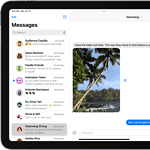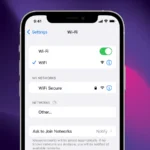MacBook Wi-Fi connection issues can be frustrating. You turn on your laptop, ready to work or browse, but the internet won’t load. To fix a MacBook that won’t connect to Wi-Fi, first restart your Mac and router, then check your Wi-Fi settings and forget the network before reconnecting.
These simple steps often solve the problem. If they don’t work, you may need to update your router firmware or change your DNS settings. Wi-Fi troubles can stem from outdated software, network conflicts, or even physical obstructions between your MacBook and router.
Don’t worry if your MacBook still won’t connect. There are more advanced solutions to try. You might need to reset your Mac’s SMC or NVRAM, which can resolve persistent Wi-Fi issues.
| Common Wi-Fi Issues | Quick Fixes |
|---|---|
| No connection | Restart Mac |
| Slow speeds | Update router |
| Intermittent drops | Change DNS |
| Network not found | Forget network |
Troubleshooting Your MacBook’s WiFi Connection
Having trouble getting your MacBook online? Don’t worry, WiFi problems are common, and often they have simple solutions. Here’s a quick troubleshooting guide to get you connected.
Basic Checks
- WiFi Enabled?: Make sure WiFi is turned on in your menu bar. It should show the WiFi icon with a signal strength indicator.
- Airplane Mode Off?: Double-check that you haven’t accidentally turned on Airplane Mode, which disables WiFi.
- Right Network?: Ensure you’re selecting the correct WiFi network from the list and entering the password accurately. Passwords are case-sensitive!
- Restart Your Devices: Restart your MacBook and your WiFi router. This simple step often resolves minor glitches.
Advanced Troubleshooting
- Check Network Preferences:
- Go to System Settings > Wi-Fi.
- Click the Advanced button.
- Make sure your preferred network is at the top of the list.
- If your network is listed but not connecting, try removing it from the list and adding it back.
- Run Wireless Diagnostics:
- Hold down the Option key and click the WiFi icon in the menu bar.
- Select Open Wireless Diagnostics.
- Follow the on-screen prompts to diagnose and fix potential issues.
- Update macOS: An outdated macOS can sometimes cause WiFi problems. Check for software updates in System Settings > General > Software Update.
- Reset Network Settings: (This will delete all your saved WiFi passwords)
- Go to System Settings > Network.
- Select Wi-Fi in the sidebar.
- Click the Details button next to your network.
- Click Make Service Inactive.
- Then, click the − (minus) button to remove the network.
- Restart your MacBook and add your network again.
| Problem | Possible Solutions |
|---|---|
| MacBook can’t find any WiFi networks | Check if the WiFi router is on and broadcasting. Move closer to the router. |
| MacBook connects to WiFi but there’s no internet access | Restart your modem and router. Contact your internet service provider (ISP) to check for outages. |
| WiFi connection is slow or drops frequently | Interference from other devices can affect WiFi. Try changing the WiFi channel on your router. |
Initial Troubleshooting Steps
When your MacBook won’t connect to Wi-Fi, a few quick checks can often resolve the issue. These steps help identify common problems with your network settings, Wi-Fi connectivity, and devices.
Checking Wi-Fi Connectivity
Start by verifying your MacBook’s Wi-Fi is turned on. Click the Wi-Fi icon in the menu bar at the top of your screen. If it’s grayed out, click to enable it.
Next, check if you can see your network in the list of available networks. If it’s not there, your router might be off or out of range. Move closer to the router if possible.
Try connecting to a different network if available. This helps determine if the issue is with your MacBook or your specific network. If you can connect to other networks, the problem likely lies with your home Wi-Fi setup.
Verifying Network Settings
Open System Settings from the Apple menu. Click Network in the sidebar. Your Wi-Fi connection should show a green indicator and “Connected” status.
If not, try removing and re-adding the network:
- Click the (…) button next to your Wi-Fi connection
- Select “Forget This Network”
- Rejoin the network by entering the password
Check your IP address settings. Click the “Details…” button next to your Wi-Fi connection. Ensure “Configure IPv4” is set to “Using DHCP” unless you’ve manually set an IP address.
Restarting Devices
A simple restart can often fix connectivity issues. Turn your MacBook off and on again. This refreshes system settings and clears minor software glitches.
Next, restart your Wi-Fi router:
- Unplug the power cable
- Wait 30 seconds
- Plug it back in
- Allow 1-2 minutes for full restart
This process clears network congestion and resets IP assignments. It’s often the quickest fix for many Wi-Fi connection problems.
If issues persist, try restarting your modem as well. Follow the same steps as with the router. This ensures your entire internet connection gets a fresh start.
| Device | Restart Method | Wait Time |
|---|---|---|
| MacBook | Apple menu > Restart | 1-2 minutes |
| Wi-Fi Router | Unplug power | 30 seconds |
| Modem | Unplug power | 1 minute |
Advanced Network Diagnostics
When your MacBook won’t connect to Wi-Fi, advanced diagnostics can help pinpoint the issue. These tools analyze your network connection, update essential components, and optimize router settings.
Utilizing Wireless Diagnostics
Apple’s Wireless Diagnostics tool offers in-depth analysis of your Wi-Fi connection. To access it:
- Hold the Option key and click the Wi-Fi icon in the menu bar
- Select “Open Wireless Diagnostics”
- Follow the on-screen instructions
The tool scans your network and provides a detailed report. It checks for interference, signal strength, and other potential issues. Pay attention to the Summary pane for quick insights.
Wireless Diagnostics also offers lesser-known features:
- Performance graphs
- Logging tools
- Wi-Fi scan results
Use these to track connection stability over time or identify crowded Wi-Fi channels.
Updating Network Driver and OS
Outdated software can cause Wi-Fi connection problems. To update your network driver and macOS:
- Click the Apple menu > System Preferences > Software Update
- Install any available updates
For a more targeted approach:
- Open Terminal
- Type “networksetup -listallhardwareports”
- Identify your Wi-Fi adapter
- Search for updated drivers on Apple’s support site
Updating macOS often includes fixes for Wi-Fi issues. It’s a simple yet effective troubleshooting step.
Analyzing Router Configuration
Your router settings can impact your MacBook’s Wi-Fi connection. To optimize:
- Access your router’s admin page (usually 192.168.0.1 or 192.168.1.1)
- Check for firmware updates
- Analyze channel settings
- Review security protocols
| Setting | Recommendation |
|---|---|
| Channel | Auto or least congested |
| Security | WPA3 or WPA2 |
| Band | 5GHz for faster speeds |
Consider resetting your router’s DHCP lease:
- In macOS, go to System Preferences > Network
- Select Wi-Fi > Advanced > TCP/IP
- Click “Renew DHCP Lease”
This can resolve IP address conflicts causing connection issues.
Optimizing Wi-Fi Performance
Enhancing your MacBook’s Wi-Fi performance involves strategic adjustments to your router setup and environment. These techniques can significantly boost connection speed and stability.
Adjusting Router Placement
Router placement plays a crucial role in Wi-Fi signal strength. Position your router centrally in your home or office. Avoid placing it near metal objects, appliances, or thick walls that can block signals. Elevate the router off the floor for better coverage.
Keep it away from windows to prevent signal leakage outside. If you have a multi-story building, place the router on the middle floor. This ensures more even distribution of the Wi-Fi signal throughout your space.
For larger homes, consider using Wi-Fi extenders or mesh systems to boost coverage in dead zones.
Changing Wi-Fi Channels
Wi-Fi routers broadcast on different channels. Overlapping channels can cause interference and slow speeds. To optimize your connection:
- Use a Wi-Fi analyzer app to check channel congestion
- Select a less crowded channel for your router
- Choose channels 1, 6, or 11 for 2.4 GHz networks
- For 5 GHz, pick any non-overlapping channel
Most modern routers can automatically select the best channel. Enable this feature in your router settings for optimal performance.
Addressing Interference Issues
Various factors can interfere with your Wi-Fi signal:
- Bluetooth devices
- Microwave ovens
- Cordless phones
- Baby monitors
Keep your MacBook and router away from these devices. Use 5 GHz Wi-Fi when possible, as it’s less prone to interference.
Update your router’s firmware regularly. This can improve performance and fix known issues. Consider upgrading to a newer router model if yours is outdated. Newer routers often have better interference management capabilities.
| Interference Source | Mitigation Strategy |
|---|---|
| Bluetooth devices | Use 5 GHz Wi-Fi |
| Microwave ovens | Increase distance |
| Cordless phones | Switch to 5 GHz band |
| Baby monitors | Change Wi-Fi channel |
By implementing these strategies, you can significantly improve your MacBook’s Wi-Fi performance and enjoy a more stable internet connection.
Alternative Solutions and Considerations
When your MacBook won’t connect to WiFi, exploring additional options can help resolve persistent issues. These approaches may involve reaching out to your Internet Service Provider or considering hardware upgrades.
Contacting Internet Service Provider
If you’ve tried basic troubleshooting steps without success, contacting your Internet Service Provider (ISP) might be necessary. Your ISP can check for outages or issues on their end. They may also help you:
- Reset your modem remotely
- Verify account status and payment issues
- Check signal strength in your area
- Schedule a technician visit if needed
Ask your ISP about running line diagnostics. This can identify problems with the physical connection to your home. If you use a VPN, disable it temporarily to rule out conflicts.
Considering Hardware Upgrades
Older MacBooks may struggle with newer WiFi standards. Upgrading your WiFi hardware can improve connectivity. Consider these options:
- Replace the AirPort card in older models
- Use a USB WiFi adapter for better reception
- Upgrade your router to support newer standards
Check your MacBook’s specifications to ensure compatibility with new hardware. Some upgrades may require professional installation.
| Upgrade Option | Pros | Cons |
|---|---|---|
| New AirPort card | Improves internal WiFi | May void warranty |
| USB WiFi adapter | Easy to install | Takes up a USB port |
| Router upgrade | Benefits all devices | Can be costly |
Before upgrading, try updating your DNS settings. This can sometimes resolve connectivity issues without hardware changes.
Frequently Asked Questions
MacBook Wi-Fi connection issues can be frustrating. These common questions address typical problems and provide practical solutions to get you back online quickly.
What steps should I take if my MacBook does not detect my Wi-Fi network?
First, check if Wi-Fi is turned on in your MacBook’s settings. Click the Wi-Fi icon in the menu bar and ensure it’s enabled. If it’s on but not detecting networks, try turning Wi-Fi off and on again.
Move closer to your router to rule out range issues. If you still can’t see your network, restart your MacBook and router.
How can I troubleshoot my MacBook not connecting to Wi-Fi while other devices can?
Start by restarting your MacBook. This often resolves temporary glitches.
Next, forget the network and reconnect. Go to System Settings > Wi-Fi > Your Network > Forget This Network. Then reconnect by entering the password again.
If issues persist, try creating a new network location in Network preferences.
Why does my MacBook fail to connect to Wi-Fi networks that it previously connected to without issues?
Outdated software can cause connection problems. Check for macOS updates in System Settings > Software Update.
Your MacBook might have outdated network settings. Try removing preferred networks and reconnecting.
Router firmware updates can also affect connections. Check if your router needs an update.
What reasons might there be for a MacBook to be unable to connect to a secured Wi-Fi network?
Incorrect password entry is a common issue. Double-check you’re using the right password.
Your MacBook’s date and time settings might be off. Correct them in System Settings > General > Date & Time.
Incompatible security settings on your router could prevent connections. Ensure your router uses WPA2 or WPA3 encryption.
How can I diagnose and fix Wi-Fi connectivity issues specific to Apple devices?
Use the built-in Wireless Diagnostics tool. Hold Option and click the Wi-Fi icon in the menu bar, then select “Open Wireless Diagnostics.”
Check for Wi-Fi interference from other devices or appliances. Move your MacBook away from potential sources of interference.
If problems persist, consider resetting the SMC (System Management Controller) on your MacBook.
In what ways can the network settings on a MacBook be reset to address Wi-Fi connection problems?
Reset your MacBook’s network settings by going to System Settings > Network > Advanced > Reset.
Use Terminal to reset the network stack. Enter the command “sudo ifconfig en0 down” followed by “sudo ifconfig en0 up”.
As a last resort, reinstall macOS to reset all system settings, including network configurations.
| Troubleshooting Step | Difficulty | Effectiveness |
|---|---|---|
| Restart Wi-Fi | Easy | Moderate |
| Forget Network | Easy | High |
| Update macOS | Medium | High |
| Reset Network Settings | Medium | Very High |
| Reinstall macOS | Difficult | Very High |







